PPC
76 Diversity & Inclusion in Marketing Statistics for 2023

American filmmaker Ava Duvanay once said, “When we’re talking about diversity, it’s not a box to check. It is a reality that should be deeply felt and held and valued by all of us.”
I agree wholeheartedly with this statement, but at the same time, I also realize that from a business and marketing standpoint, there is a need to put some structure, and maybe even checklists, into place in order to build a true culture, brand voice, and community around these concepts of diversity equity, and inclusion.
And each year, these efforts have become more and more important, not just for society but for any given business’s health. That’s why we have plenty of resources on improving diversity, equity, and inclusion (DEI) for your business, and why we’re adding another one: this list of DEI stats and findings from studies—plus key takeaways—to help you
- Broaden your perspectives.
- Inform your strategy around diversity and marketing.
- Build stronger connections with all groups within your target audience.
Table of contents
Jump to statistics about:
Statistics about the growing power of the minority consumer population
These statistics are helpful in getting a feel for the growing power of minority groups among consumers, including Hispanic, Black, and Asian American groups.
- In the past decade, the white population declined for the first time in history (2.6%), while people who identify as Black, multiracial, Hispanic, and Asian drove population growth (NY Times).
- The Census Bureau projects that in the next 25 years, non-Hispanic whites will account for less than half of the U.S. population (Forbes).
- The buying power of minority groups in the U.S. is exploding. It was $4.2 trillion in 2020 and is projected to reach $7 trillion by 2025 (Insider Intelligence).
- The median age among multicultural consumers is younger than non-Hispanic whites: For Hispanics it is 30, for Blacks 35, for Asian-American 38 and for non-Hispanic whites it is 44 (Forbes).
The takeaway: While it’s important from a diversity perspective to adjust your marketing content to resonate with the different people groups within your target audience, these stats show that it’s also becoming more and more practical.
Statistics about the impact of inclusive marketing on consumers
These stats on inclusive advertising come from a range studies conducted by Google, Deloitte, Microsoft, Facebook (Meta), and more.
- 64% of consumers said they took some sort of action after seeing an ad that they considered to be diverse or inclusive (Think With Google, 2019). This percentage is higher among specific consumer groups including Latinx+ (85%), LGBTQ (85%), Black (79%), Asian/Pacific Islander (79%), Millennial (77%), and teens (76%).
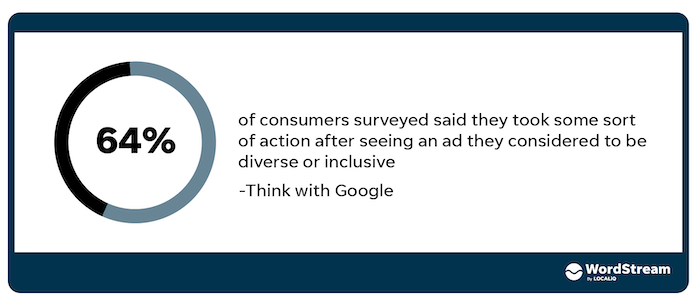
- According to a June 2020 survey, 42% of responding Americans wanted to see more racial diversity in advertising (Statista).
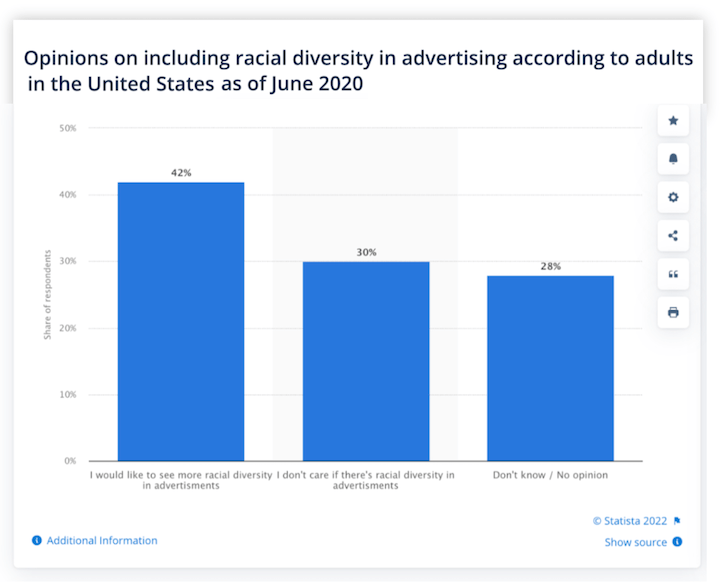
- In that same study, 55% of 18-34-year-olds wanted to see more racial diversity in advertisements, compared to 32% of 65+ year-olds (Statista).

- A study by Microsoft) showed that an inclusive ad drove a 23 pt. lift in purchase intent whether the person experiencing the ad was personally represented in the ad or not. The highest lift was in Caucasians (+38 pt) compared to women (+26), men (+18), and ethnic minorities (+11 pt).
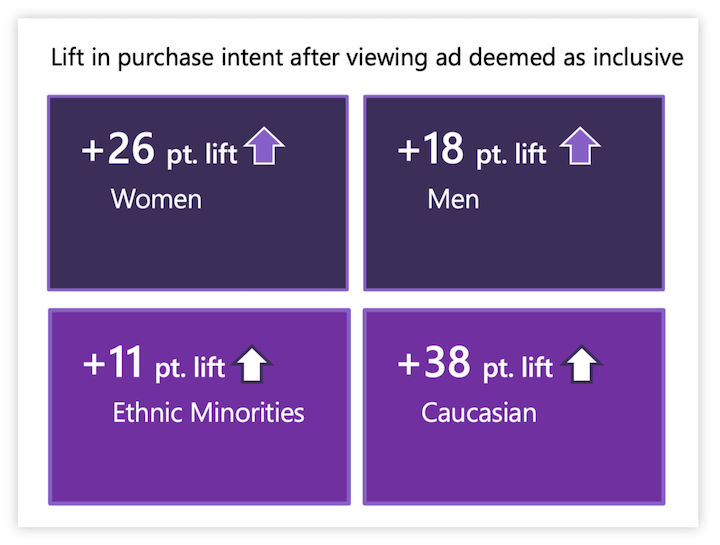
- Facebook found that online campaigns with more diverse representation had higher ad recall in 90% of the simulations they ran.
- The majority (54%) of consumers surveyed in the Facebook study said they do not feel fully culturally represented in online advertising and most (71%) expect brands to promote diversity and inclusion in their online advertising (Facebook).
- Some 59% of consumers polled said they are more loyal to brands that stand for diversity and inclusion in online advertising, and 59% also said they prefer to buy from brands that stand for diversity and inclusion in online advertising (Facebook).
- Two out of three Americans say their social values now shape their shopping choices (McKinsey, 2021)
- 45% of consumers believe retailers should actively support Black-owned businesses and brands. (McKinsey, 2021)


The takeaway: While consumers may not look down upon a brand if it doesn’t demonstrate inclusion in its marketing collateral, they are more likely to appreciate, trust, engage with, and purchase from a brand that does. Moreover, the Inclusive Consumer, proactively seeking out ways to support minority businesses and causes they care about, can be a valuable resource for building a genuine community of diversity, equity, and inclusion around your brand.
Statistics about business involvement in societal issues
The stats below reveal how consumers think businesses should approach and address issues in society like sustainability and economic inequality.
- 68% of consumers believe CEOs should step in when the government does not fix societal problems (Edelman Trust Barometer, 2021).
- Consumers think businesses aren’t doing enough to address societal issues like climate change (52%), economic inequality (49%), workforce reskilling (46%) and trustworthy information (42%) (Edelman, 2022).

- In one study, 94% of Gen Z respondents expect companies to take a stand on important social issues, and 90% say they are more willing to purchase products that they deem beneficial to society (Deloitte, 20222).
- Consumers aged 18-25 years old take greater notice of inclusive advertising when making purchase decisions than consumers 46+. (Deloitte, 20222).
- 57% of consumers are more loyal to brands that commit to addressing social inequities in their actions (Deloitte, 2022).
Takeaway: It may be worth it to conduct a poll or survey to get a feel for which societal issues are most important to your target audience and what they expect of your brand in relation to them. This could help you avoid marketing blunders and reputation mishaps and maybe even inspire a new and creative marketing campaign.
Statistics about perspectives among minority consumer groups
Here are some statistics to help you broaden your understanding on how specific minority groups among consumers experience and perceive diversity efforts in marketing.
The Black community
- One in three Black consumers doubts the intentions of social media-run businesses that launch Black History Month campaigns and promotions (Insider Intelligence, 2022).
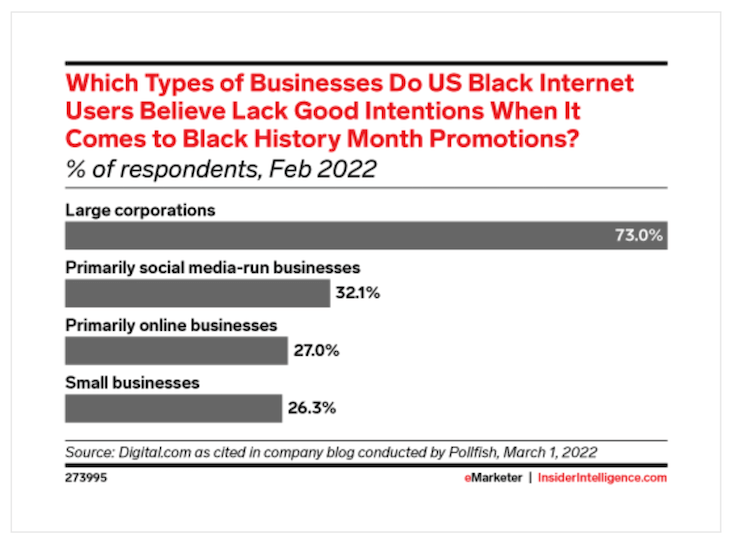
- Black correspondents said they were more likely to purchase from (69%), proactively seek out (69%), interact with (67%) return to (66%), and recommend (65%) brands whose advertising positively reflects their race/ethnicity (Think With Google, 2019).
- On average, only 38% of Black consumers feel brands understand them (My Code Media).
- 58% of Black consumers say it is important that culturally relevant advertising makes them feel like brands understand them (My Code Media)
- 78% of Black adults feel online racial hate is a serious problem.
The Hispanic community
- Despite making up 18.7% of the total US population, Hispanic consumers make up a disproportionately small percentage (only 6%) of overall advertising spend (Insider Intelligence, 2021).
- 54% of Hispanics feel they can better influence social issues through the brands they buy than with who they vote for—more so than other demographics. (Edelman Trust Barometer, 2021)
- Since January 2020, the Latinx community has been disproportionately affected by economic downturns, yet 56% feel optimistic about the next five years—more than any other ethnic community. (Edelman Trust Barometer, 2021)
- Only four in 10 Hispanic adults feel brands and companies understand them very well, on average. From an industry perspective, they feel brands in the consumer electronics industry have the best “above-average understanding” while those in the auto industry understand them the lowest “above-average understanding” (My Code Media).

- Seven in ten Hispanic adults say they trust brands or companies more, and are more motivated to buy from those brands, when they feel understood by them (My Code Media).
- In their own words, Hispanic adults are 2.6 times more likely than non-multicultural adults to say they want to identify with the people in the ‘mainstream’ creatives more, and 3.2 times more likely to say the ‘mainstream creatives’ need more diversity (My Code Media).
The LGBTQ community
- 76% of LGBTQ community members think more positively about companies that sponsor LGBTQ community organizations and events (CMI).
- 71% of LGBTQ community members are more likely to purchase from a company that does outreach and advertises to the LGBTQ community (CMI).
- 69% of LGBTQ community members think more positively about companies that advertise in the LGBTQ media (CMI).
- 67% of LGBTQ-supportive companies have made a positive difference for their LGBTQ employees (CMI).
- Openly supporting LGBTQ legislation is the top indicator that a company supports the LGBTQ community, followed by speaking out against discrimination of transgender/nonbinary community members., supporting programs for LGBTQ youth, donating money to LGBTQ non-profits, creating advertisements featuring LGBTQ imagery, and sponsoring local Pride celebrations (CMI).
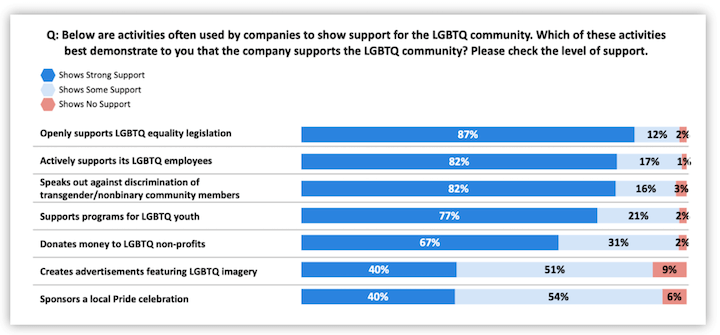
- Only 53% of LGBTQ community members think that corporate presence at LGBTQ Pride events is positive for the community. When you break it out by age, only 27% of people aged 18-34 agreed with this while 74% of people 55 or over agreed (CMI).

- Non-LGBTQ consumers look favorably upon companies that include LGBTQ people in their advertisements (GLAAD).
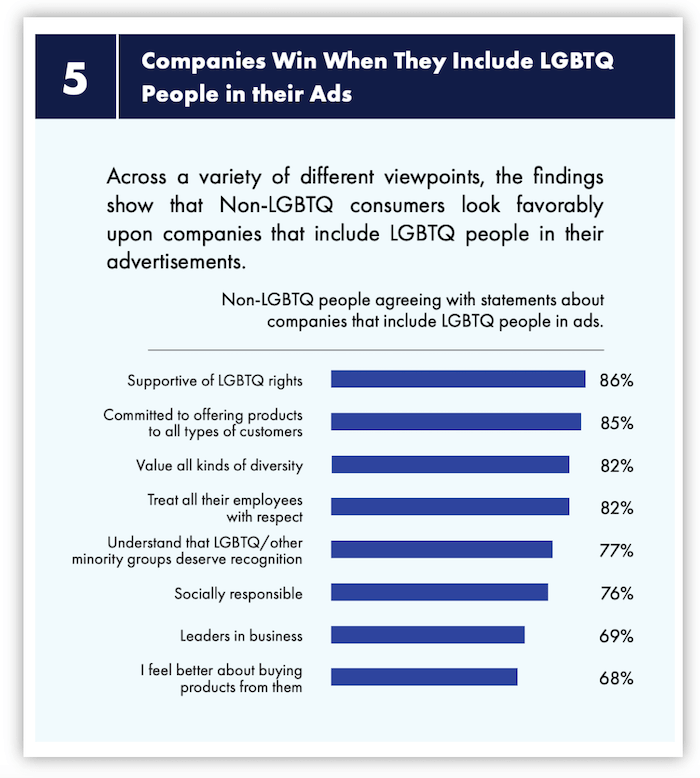
- 77% of non-LGBTQ people feel more positively ward brands that include LGBTQ people in their advertisements (GLAAD). They agree with the following statements about those companies:
- Support LGBTQ rights (86%)
- Offer products to all types of customers (85%)
- Value all kinds of diversity (82%)
- Treat all their employees with respect (82%)
- Understand that LGBTQ and other minority groups deserve recognition (77%)
- Socially responsible (76%)
- Leaders in business(69%)
- Feel better about buying products from them (68%)
- On average, non-LGBTQ people who were exposed to LGBTQ people in the media were 38% more likely to become more accepting and supportive of LGBTQ people (GLAAD).

- LGBTQ respondents said they were more likely to purchase from (68%) and trust (71%) brands with advertising that positively reflects a variety of sexual orientations (Think With Google, 2019).
- 71% of LGBTQ respondents said they are more likely to interact with an online ad that authentically represents their sexual orientation (Think With Google, 2019).
- 67% of LGBTQ respondents said they are more likely to feel positively toward brands with advertising that demonstrates that men and women have the same capabilities and roles (Think With Google, 2019).
Asian American and Pacific Islander community
- The Asian American and Pacific Islander community (AAPI) makes up one-tenth of the U.S. population, but it almost doubled from 2000 to 2019 and is projected to become the largest population cohort by 2060 (My Code Media).
- AAPI consumers’ economic power is growing faster than the country s a whole (My Code Media).
- Only three in 10 AAPI adults feel brands and companies understand them very well, on average. For this study, they rated consumer electronics as having the highest “above-average understanding” and financial services as having the lowest (My Code Media).

- Seven in 10 AAPI adults say they trust brands or companies more, and are more motivated to buy from those brands, when they feel understood by them (My Code Media).
- Only three in 10 AAPI adults say they can identify with culturally relevant creatives (My Code Media).
- In their own words, Hispanic adults are 2.8 times more likely than non-multicultural adults to say they want to identify with the people in the “mainstream” creatives more, and 2.9 times more likely to say the “mainstream” creatives need more diversity (My Code Media).
The multicultural female community
- One in five women in the U.S. are multicultura women, and this share of the population is growing while the non-multicultural women’s share is declining (My Code Media).
- Multicultural women are pursuing higher education more than a decade ago, and their incomes are rising (My Code Media).
- Women, overall, make up more than half of the U.S. population and control or influence 85% of consumer spending (My Code Media).
- Only four in 10 multicultural women feel brands and companies understand them very well, on average. The industry they indicate with the highest “above-average understanding” is consumer electronics, and the one with the lowest is auto (My Code Media).

- Seven in 10 multicultural female adults say they trust brands or companies more, and are more motivated to buy from those brands, when they feel understood by them (My Code Media).
- Only four in 10 AAPI adults say they can identify with culturally relevant creatives (My Code Media).
- Multicultural women are three times more likely than multicultural men to mention identifying with a person’s gender when describing culturally relevant ads (My Code Media).
- Over five in 10 multicultural women feel it’s important that advertising illustrates a clear stance on issues htey care about (My Code Media).
- Culturally relevant creatives are 21% – 76% more compelling for AAPI, Black, and Hispanic women.
- In their own words, Hispanic adults are 2.8 times more likely than non-multicultural adults to say they want to identify with the people in the “mainstream” creatives more, and 2.9 times more likely to say the “mainstream” creatives need more diversity (My Code Media).
Takeaway: Reaching the specific minority groups within your target audience is only the first step. It takes a holistic, consistent, and structured approach to ensure you are connecting with these groups on a meaningful level, demonstrating true understanding of them, representing them accurately and appropriately, and meeting their needs.
Accessibility in marketing stats
- The World Health Organization reports that globally, 15% of the population lives with a disability.
- 26% of U.S. adults live with some type of physical or mental disability (CDC). Functional disabilty types include mobility, cognition, independent living, hearing, vision, and self-care.
- Deloitte found that high-growth brands (annual revenue growth of 10% or more) are more frequently establishing key performance metrics for DEI objectives than their lower-growth competitors.
- 69% of marketers believe that providing accessibility features is important to executing successful marketing campaigns (Capterra).
- 83% of marketers say their company is doing more to provide accessibility in digital marketing than in the past (Capterra).
- Only 35% of marketers say their company accounts for physical ability when marketing to consumers (Capterra).
- Almost half (49%) of marketers say that social media is the most difficult platform for accessibility (Capterra).

Follow our tips on how to make your social media more accessible here.
- 18% of marketers rate their company’s visual, hearing, cognitive, and mobility features as ineffective (Capterra).
- Half of all marketers (50%) don’t realize there is a U.S. law requiring federal government websites to be safe and accessible for people with disabilities (Section 508) (Capterra).
- Marketers report that their company is more likely to provide visual (66%) and hearing (56%) accessibility features than cognitive ones. They also believe that hearing and visual disabilities are most prevalent, but the truth is that cognitive disabilities are (10.8% compared to hearing (5.9%) and vision (4.6%)) (Capterra).
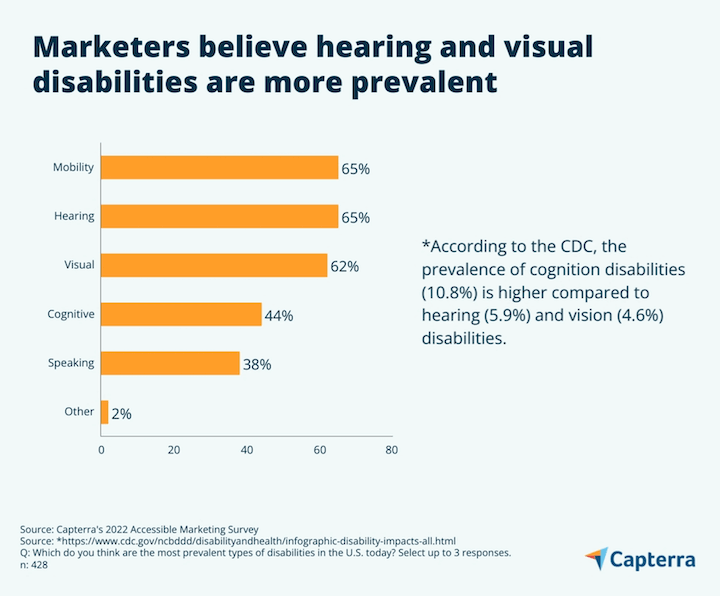
- 45% of marketers say that education or accessibility training would motivate their company to be more proactive in improving its accessibility. But one in four marketers say that lack of technology and/or staff to implement accessibility training and features is a top challenge in achieving this (Capterra).
Here are some more stats from Monsido on website accessibility:
- 90% of websites are inaccessible to people with disabilities who rely on assistive technology (AbilityNet).
- 98% of home pages have detectable WCAG 2 failures with low contrast being the most common (86.3%) (WebAIM)
- People with disabilities spend a half-trillion dollars annually (UsableNet).
- 82% say they would often return and spend more with a company that provides an accessible online experience (Click-Away Pound).
- Two out of three e-commerce transactions are abandoned by people who are blind because of lack of accessibility (US Department of Commerce).
- Companies without accessible sites are losing $6.9 billion a year to competitors whose sites are accessible (US Department of Commerce).
Takeaway: Creating an ADA-compliant website should be a top priority for your business, but not the only effort you put into place to meet the needs of those with disabilities in your target audience. Be sure to educate yourself on the specific types of disabilities that are prevalent among your customers and incorporate your efforts into your social media, email, and events as well.


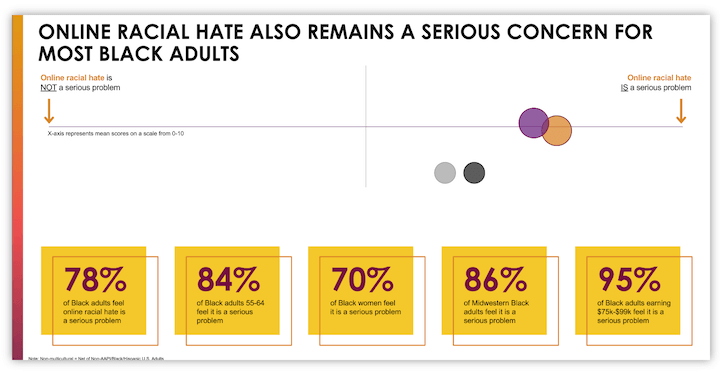

















You must be logged in to post a comment Login